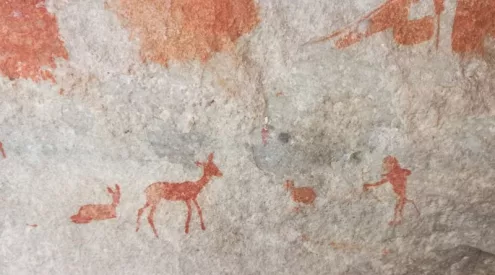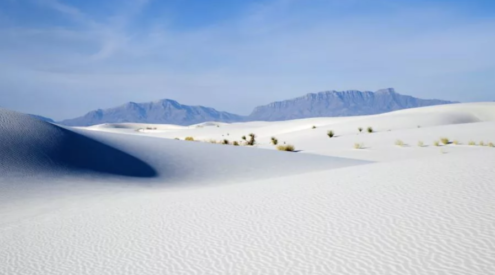Mount Kilimanjaro is Africa’s tallest peak and the tallest free-standing mountain in the world. It is often the first high-altitude climb that most people attempt because it is assumed to be reasonably safe and accessible. Francis and I were fortunate to climb this incredible mountain in January.
Flying into Tanzania from Kenya is an unforgettable experience. The first glimpse I got of the 5895 m mountain was out of our aircraft window as we banked sharply to land at Kilimanjaro International Airport just outside Moshi. We landed just as the sun was setting, and as we stepped off the plane we were welcomed by the orange glow of a typical African sunset.
We arrived at Keys Hotel in Moshi an hour later and met up with our two fellow climbers who had flown in from the USA. After a brief introduction and a chat we headed off to bed.
Lemosho Route
We had chosen to climb the Lemosho Route to the summit of Kilimanjaro. The main reason was for acclimatisation. The Lemosho route is the longest route and we would be on the mountain for almost 10 days and we hoped that we would acclimatise well in that time. Mountain sickness is something that climbers want to avoid at all costs, and by acclimatising properly, the climber runs less risk of getting ill. We arrived at the gate in the mid morning and our Chief Guide, Raj, went off to organise our climbing permits for us. Once that was all done our porters were selected and we set off on our adventure.
The Terrain
While climbing Mt Kilimanjaro, we traversed pretty much all the climatic zones on Earth. There are five different climatic zones that are covered during the climb. The first is on the lower plains where indigenous vegetation has been removed and coffee and banana plantations are abundant. The next zone is the forest belt – a typical rainforest with heavy undergrowth, lots of ferns, trees, abundant wildlife and a warm, moist climate. We then moved up to the Alpine Heath and Moorland zone which starts at an altitude of 2800 m. In this zone there are small scrubby bushes and almost no shade. There are lots of flowers, but mostly small shrubs and bushes. In the Moorland, the vegetation starts thinning out and giving way to volcanic rocks and soil. There are no large mammals at this altitude and only occasionally a small bird. The Highland Desert (4000 – 5000 m) is next and here you begin to feel the reality that you are now on a mountain. The days in this zone are warm and the nights are cold. Once the sun drops below the horizon the cold sets in rapidly. There is no vegetation to speak of, it looked almost as if we had landed on the moon. Massive boulders punctuate the scenery and dry, grey volcanic soil is everywhere and gets into everything. Finally there is the Ice Cap zone, which occurs above 5000 m. At this stage there is nothing but rock scree and volcanic soil, and the occasional glacier (most of which are now melting). The conditions are arctic and mostly below freezing at any time of the day. The oxygen level is about 50% less than at sea level.
Climbing Mt Kilimanjaro
The route that we chose took 10 days of climbing. On average we hiked between eight and 14 kilometres per day in varying altitudes. It was an incredible experience to be on the mountain for so long and to see Tanzania from such an amazing vantage point. Once we got higher on the mountain, the effects of altitude could be felt very clearly. On day four I suffered from a bout of altitude sickness. I felt nauseous, light headed, I had a headache in the base of my skull and throughout the day felt as if I was walking beside my body. It was not a good day, and at the end of the days climbing I truly felt that I might have to get off the mountain. Altitude sickness is not a joke, Martina Navratilova was evacuated off Mt Kilimanjaro in November because of it. At one of the higher camps on the mountain, we witnessed a few porters suffering from altitude sickness and they too had to be evacuated. If left unchecked, it can lead to serious injury and ultimately death. I wasn’t taking any chances and when I arrived at the high camp I informed our Chief Guide about how I felt. He looked at me and said in his warm Swahili accent, ‘this is common, but I will fix you, I am a witchdoctor.’ Ok “¦ enough said, but at that stage I felt so bad that I would have done just about anything to feel better. He mixed up a cocktail of chopped garlic and chopped ginger in a teacup and poured a quarter cup of boiling water over it. He said I must sip this while still hot and swallow the garlic and ginger. Hmmmm it did not taste good, especially because I felt so nauseous, but I did as I was told and went straight to bed. The next morning I woke up feeling better than ever and in fact, never felt even slightly ill again during the rest of the climb.
Each day was tough on the mountain, don’t be fooled – Mt Kilimanjaro is not an easy climb. It is physically taxing and mentally demanding. As we climbed higher and higher, we realised that getting to the summit was going to be tough, this was the real thing. We climbed with an expedition company, its probably the best way to make an attempt at Mt Kilimanjaro. We used a company called Adventure Dynamics, run by Sean Disney, I would HIGHLY recommend them, they are a professional company with a great track record of high altitude expeditions, not only on Mt Kilimanjaro, but pretty much all the seven summits and more.
Porters
The real unsung heroes of the mountain are the porters. These tough men carry between 15 and 25 kgs of equipment up the mountain. For each person climbing, five porters are needed. We were a group of five climbers and we had 23 support staff assisting us. Their duties included carrying all our stuff up the mountain, like tents, food, extra clothing, cooking equipment, our dining room tent (yes we ate on chairs and had a dining tent) and even a portable bucket toilet. To say that these guys are heroes is an understatement, they are super human. Many of them climb the mountain each week and are only back home for two days before they embark on the next expedition. They are truly the toughest, strongest and most resilient men I have ever seen. Without them, no one would make the summit, of that I have no doubt. They are truly the toughest, strongest and most resilient men I have ever seen. Without them, no one would make the summit, of that I have no doubt. These porters work in very tough conditions and there is a non-profit organisation that monitors the use of the porters. Read more about the Kilimanjaro Porters assistance project.
Going for the summit
On the eve of our summit, we arrived at Barafu High Camp in the afternoon. The camp was 4600 m above sea level and the summit of Mt Kili is 5895 m above sea level. That means, on our summit night we would have to climb 1295 vertical metres and would hike 10 km overall to get to the summit and back. No mean feat, considering we were breathing much less oxygen and we had hiked about 55 kms already over pretty rugged terrain.
We arrived at Barafu at about 4pm and were told that we would get dinner by 5:30pm and then we needed to get to sleep by 6:30pm. We would then be woken at 11 pm and we would begin our summit attempt at midnight. This all went well and we were woken at 11pm “¦ to a howling wind that was threatening to uproot our tent with us in it. The sky was clear, so there was no chance of snow, but with the wind chill we were in temperatures that were way below freezing. We put on all our different layers, I had six layers on top, three layers on the bottom and two pairs of gloves. As we started our ascent up the scree slope behind the Barafu camp, I looked up and saw a snaking trail of small lights above me. It was other climbers ahead of us on the mountain, making their bid for the summit. The scene looked amazing – the stars were bright above us, but the wind was horrendous. It was a strong wind coming from the right side and as we zigzagged up the mountain in absolute darkness apart from the small focused light of our headlamps, I realised that I had lost feeling in my fingers and my toes. The wind was howling so loud, that I could not hear anyone talking unless they shouted into my ear. I never wore a balaclava, but decided to use a buff to cover my nose and mouth to protect me from the elements. This was fine until I realised that when I was walking into the wind, the moisture from my breath was freezing on the buff and stopping me from getting air, I would then have to pull the buff down and suck in air as deeply as I could. After four hours of doing this, my lips were split and purple and I still don’t have full feeling back in my bottom lip, possibly a touch of frostbite.
It took 10 hours of gut-wrenching climbing to reach the summit of Mount Kilimanjaro. The last 300 m were the toughest by far. Your body is spent, your mind is finished and all you want to do is get back down to camp. It is sheer willpower that drives people on at this point. I managed to get to the summit at 10am and to be honest, it was a bit of an anticlimax. I was absolutely hammered – I could barely put one foot in front of the other. As I stood there and looked out over the plains of Tanzania, it didn’t quite sink in that I was standing on top of Africa. I managed to take a few photos and then headed back down to the camp, which took another four hours. By the time I got there I was physically, mentally and spiritually spent. I had nothing left. I remember lying in the tent at 4600 m and saying to Francis that I don’t want to see another hiking bag again.
We hiked down to a lower camp that evening and spent the night at 3900 m. The next day we hiked out to the main gate at Mount Kilimanjaro National Park.
It was only as we flew out of Tanzania in the early hours of the next morning that I realised what I had done. As we took off from Tanzania to fly to Kenya, the sun was rising and just illuminating the silhouette of Mt Kilimanjaro. I looked at this massive mountainous volcano and realised then, that I had stood on the summit of the tallest mountain on Africa and had achieved a long time personal goal. The reality set in only at that point, it was a quiet realisation that this had been achieved. It was a good feeling to be viewing that mountain from the relative comfort of a plane and think that two days before in sheer pain and utter exhaustion, I had clambered to her summit. Finally I could understand those word of that famous song “¦ I’m sitting on top of Kilimanjaro “¦ indeed I had sat there, it was something I will never forget.
















